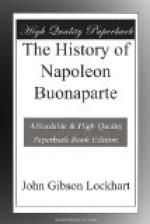The tempest abated in the morning—but the weather all day long was gusty, and the sky lowering. It was about noon that the French opened their cannonade, and Jerome Buonaparte, under cover of its fire, charged impetuously on Hougomont. The Nassau men in the wood about the house were driven before the French; but a party of English guards maintained themselves in the chateau and garden, despite the desperate impetuosity of many repeated assaults. Jerome, masking the post thus resolutely held, pushed on his cavalry and artillery against Wellington’s right. The English formed in squares, and defied all their efforts. For some time both parties opposed each other here, without either gaining or losing a foot of ground. At length the English fire forced back the French—and the garrison of Hougomont were relieved and strengthened.
The next attempt was made on the centre of the British line, by a great force of cuirassiers and four columns of infantry. The horse, coming boldly along the causeway of Genappe, were met in the path by the English heavy cavalry, where the road has been cut down deep, leaving high banks on either side. Their meeting was stern: they fought for some time at sword’s length; at last the cuirassiers gave way, and fled for the protection of their artillery. The English followed them too far, got amidst the French infantry, and were there charged by fresh cavalry and driven back with much loss.—It was here that Picton died. Meanwhile the infantry of this movement had pushed on beyond La Haye Sainte, and dispersed some Belgian regiments; but being then charged in turn, in front by Pack’s brigade of foot, and in flank by a brigade of heavy English horse, were totally routed—losing, besides the slain and wounded, 2000 prisoners and two eagles. The only favourable result of this second grand attempt was the occupation of the farmhouse of La Haye Sainte, which had been garrisoned by Hanoverians. And scarcely had the charge of Pack proved successful, ere the French were again compelled by shells and cannon to evacuate this prize.
The third assault was levelled again on the British right—where the infantry awaited it, formed in a double line of squares, placed chequerwise, and protected in front by a battery of thirty field pieces. The French cuirassiers charged the artillerymen and drove them from their guns; and then rode fiercely on the squares behind. These remained steadfast until the enemy were within ten yards of them, and then fired with deadly effect. The cavalry gave back—rallied again, and renewed their charge: this they did several times—and always with the like result. Sometimes they even rode between the squares, and charged those of the second line. At length protracted exposure to such cross fire completed the ruin of these fearless cavaliers. The far greater part of this magnificent force was annihilated in this part of the battle.




